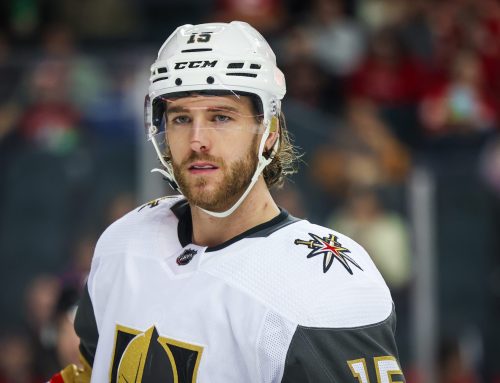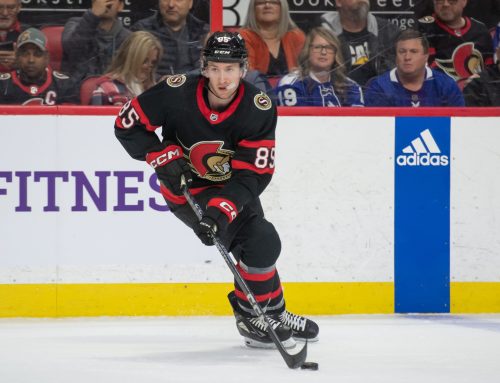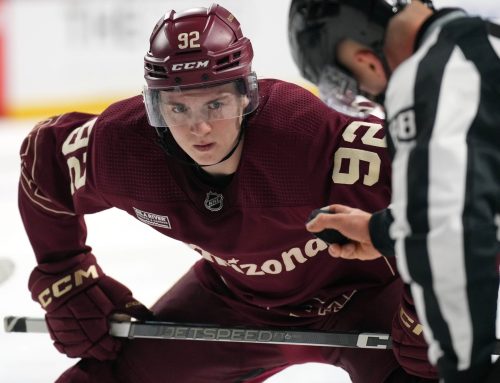Ramblings: Pens Take Game Two; Blue Jackets Fantasy Performances; Keller – June 1
Michael Clifford
2017-05-31

Nashville-Pittsburgh
One player with a revelatory performance so far these playoffs, particularly since the Ryan Johansen injury, has been Pontus Aberg. Despite just 15 regular season games to his name, he picked up his fourth point in his last four playoff games since Nashville’s top line center went out, and it was a beautiful goal:
What a goal by Pontus Aberg pic.twitter.com/izIeE9oj58
— Pete Blackburn (@PeteBlackburn) June 1, 2017
Olli Maatta has had very positive performances these playoffs, but that goal by Aberg, and the one where he got out-skated by Bobby Ryan in overtime of the first game in the Ottawa series, show there is still some consistency missing in his game. Hopefully a healthy offseason can get this young defenceman on track next year.
Jake Guentzel would tie the game late in the first period with his 11th playoff goal, and give Pittsburgh the lead just 10 seconds into the third period with his 12th playoff goal. Goals from Scott Wilson (which was another own-goal for the Predators, their second of the series) and Evgeni Malkin in the next three-or-so minutes buried the Predators. Game Three is back in Nashville on Saturday.
****
Columbus Blue Jackets
Throughout the summer, I am going team-by-team to review some of the individual players’ fantasy performances, and what it could mean for next year. The next team on our alphabetical journey is the Columbus Blue Jackets.
There is no better place to start than the likely Vezina Trophy winner doubling as the fantasy MVP.
Not much needs to be said here as he was mostly dominant from the start to the finish of the season with a little hiccup in the middle. He joined Carey Price as the only goalies in NHL history with a season containing 40 wins, a save percentage of .930 or better, and a goals against average of 2.10 or lower.
Here lies the problem: no goalie has posted a .930 save percentage in back-to-back seasons (with a minimum of 50 starts), and Tim Thomas is the only goalie to have ever attained that mark in any two seasons. In fact, if we lower the threshold to a .925 save percentage, only Tomas Vokoun and Carey Price have managed to reach that mark in back-to-back seasons with 50-plus starts.
There is no doubt that Bobrovsky can be a top-end fantasy goalie next year, but it’s a matter of expectations. If fantasy owners are hoping for anything close to his 2016-17 performance, they’ll be bitterly disappointed. I imagine he’ll be among the top-3 goalies in drafts, and a .920 save percentage with 35 wins and a 2.30 goals against would put him at, or outside, the top-5 fantasy goalies. That’s an excellent season, but will be a letdown based on expectations. It’ll be interesting to see where his ADP falls.
Zach Werenski
The 47 points from Werenski were the most for a rookie teenage defenceman since Tyler Myers in 2009-10 (48), and the sixth-most all-time for that group.
Fantasy owners might see Werenski in the same sentence as Myers and freak out a little bit. I wouldn’t. Two things separate them: Werenski drives the play, and shoots a lot. That volume provides a bit more reliability in goal-scoring: Myers shot over 10 percent that year which is extremely high for a defenceman (he’s shot 7.6 percent since); Werenski was at 5.9 percent this past year, which is much more normal. He was also one of the top volume shooters for defencemen in the NHL this year.
Playing with Seth Jones helps a lot. The former Nashville blue liner had established himself as a play-driver, and that fit in very well with his Columbus teammate. Werenski appears to be that as well, and that’s another big point of differentiation between he and Myers.
I don’t have concerns for next year. The power-play points may not increase a lot (the Jackets PP was unstoppable for the first few months, which is what really made a difference here). Even if there isn’t much increase in power-play production, all of his five-on-five numbers were perfectly reasonable. With the additional ice time he should receive, there’s no reason to think he can’t repeat a 45-point performance barring some bad luck and/or injury.
I remember reading some passing judgment on Saad after he was traded from Chicago that he was simply a product of playing with Jonathan Toews. In the two seasons since arriving in Columbus, he is tied for ninth in the league in five-on-five goal scoring, sixth in goals per 60 minutes, and tied for 11th in five-on-five points per 60 minutes. Over the last four seasons, his five-on-five goal total (70) is in the same neighbourhood as Jamie Benn (73), John Tavares (73), and Brad Marchand (69). He’s played fewer minutes than all of them.
That is what makes Saad’s season last year so frustrating. Not only is he productive, but he’s a very good play driver. He does absolutely everything a coach could possibly want a player to do, and yet there were times last year he was demoted, benched, and removed from the power play altogether (even though they ran the top unit heavily anyway). Unless he gets those top power-play minutes – he got less per game than Oliver Bjorkstrand – his upside is capped.
Maybe things change next year, but that’s back-to-back seasons that he’s played under 1400 total minutes (he missed just four games combined). Over the last four years, there have been 250 instances of a forward playing at least 80 games and not cracking 1400 total minutes. Of those 250 players, none had more than 65 points, and nine had more than 60 (3.6 percent of all such players). Until his opportunities change, one of the most efficient forwards in the NHL will be hard-pressed to reach his fantasy potential.
Though the goals were few and far between with just 13, Wennberg managed 46 assists last year, for a very solid 59-point season. That included 23 power-play points, which is what drove a lot of his fantasy value. Anytime a 22-year-old centre who was basically free in one-year fantasy drafts puts up as many power-play points as Patrick Kane, it was a good season.
Again, to an extent, we run into the problem with some other players on this team – his value is completely dependent on his line mates, and particularly the power play. He is coming into his expected prime as a player, and yet his shot differentials with and without guys like Brandon Saad or Nick Foligno over the last few years aren’t very good. For roto leagues that count several categories, he barely shoots, and he doesn’t take penalties. While he took a step forward production-wise in 2016-17, it mostly came from power-play assists. Nothing else improved meaningfully.
Wennberg reminds me precisely of Tyler Bozak circa 2014. He’s a first-line centre by virtue of the team he plays on and the opportunity afforded him; he’s not a true first-line centre. That’s all that really matters for fantasy, however. If John Tortorella is going to leave him on the top power-play unit, and give him over 18 minutes a game, it really doesn’t matter how good or bad his underlying stats are. He could sleepwalk his way to a 50-point season. For those in roto leagues, however, there’s been no indication at any point of his NHL career that he can be anything more than a playmaker. That’s fine – every fantasy team can use one. Just don’t expect him to help you across the board.
****
Thinking back on the 2016-17 season, the overarching storyline clearly was not only the emergence of the next wave of elite NHL players, but how dominant they were. There were six rookies with at least 20 goals, and four with at least 60 points. It truly was a special year to be a hockey fan (and a dynasty fantasy hockey owner, if you had the right players).
The 2017-18 season may not boast the same level of rookie talent, or sheer numbers, but that doesn’t mean there aren’t gems to be found. It is simply a matter of trying to figure out what situations might lead to a breakout rookie season. Outside of the potentially generational talents in Auston Matthews and Patrik Laine, the rookies with solid fantasy seasons last year satisfied at least one of the following two conditions:
- Played on a high-scoring team, like William Nylander, Mitch Marner, Brady Skjei, or Zach Werenski.
- Playing a featured role like Matthew Tkachuk or Sebastian Aho.
Sometimes a player satisfies both conditions like Werenski did, and that’s even better. A third condition – getting a bit lucky – could apply to some players like Mikko Rantanen, but there’s nothing to be gleaned from that.
One rookie that I’ll be buying on because he should at least be in a feature role is Clayton Keller. That link attached to his name will get you to his section in Dobber Prospects.
It’s clear that Keller has a bright NHL future; any fantasy owner worth their salt knows that. This is a matter of being willing to pay more than anyone else at the draft table in September. Keep in mind that guys like Nylander, Marner, Werenski, and Aho were likely all drafted outside the top-200 in fantasy drafts last year (in one-year leagues). It’s not unreasonable to think that Keller will easily fall outside the top-10 rounds in a 12-team draft.
What is most important here is that he should be given ample opportunity to succeed. Last year, Shane Doan and Martin Hanzal were both among the top-6 Coyotes forwards in even-strength ice time per game, while names like Alex Burmistrov and Brandon Perlini were top-6 in power-play ice time per game. There is no reason to think Keller can’t be top-6 in both aspects for this team, which likely means at least 16 minutes a game, including ample power-play minutes.
There should be hesitation with drafting any Coyotes player too high but, as mentioned above, I can’t imagine he goes anywhere inside the top-120 picks, maybe even top-150. At that point, it’s worth taking the risk on a player with so much high-end skill.
5 Comments
Leave A Comment
You must be logged in to post a comment.





 BOS
BOS OTT
OTT CBJ
CBJ CAR
CAR MTL
MTL DET
DET PHI
PHI WSH
WSH FLA
FLA TOR
TOR WPG
WPG SEA
SEA VAN
VAN CGY
CGY VGK
VGK CHI
CHI EDM
EDM COL
COL S.J
S.J NYI
NYI

Michael.
What is a 1st line C?
“He’s a first-line centre by virtue of the team he plays on and the opportunity afforded him; he’s not a true first-line centre. ”
He finished tied for 15th in scoring for C’s with Kuznetsov at 59 points in only his 3rd full season in the league. He has just reached my threshold for breakouts by forwards having played 207 regular season games. My breakout point is in or around 200 games unless a monster forward 6’3″ & over then 400 games like Dman. I have Wennberg as a 70 point player next season, he is an incredible passer & distributor of the puck & will never be a goal scorer.
I would add – unless a forward 5-9 or under for 400 games as well. Good theory though. Maybe I’d do 240 and 440 as my GP threshold, otherwise this is sound.
There appears to be a trend developing that some players are starting to breakthrough later. B. Schenn types but not enough data yet to define as such. It’s not hard & fast though. I call it the 80/20 rule, give or take 5% year to year & in or around 200 games, 40 in either direction works for me. The primary issue with my system is many players fall right into this category at seasons end. There just starting to blossom, the season ends & we have to pick it up next season & moving forward.
I got bogged down with work this week even though I have been home for months & didn’t get Buffalo posted. Hope to today & continue. Had hoped I could hit all 30 teams. But June 18th is coming fast.
Yay!!
A first-line centre, to me, is a guy that can not only put up 60-plus points (or in that neighbourhood), but a guy who can drive the bus for his line mates. As I mentioned, he hasn’t shown to be able to drive the play yet, and given he’s played three seasons, it’s something he should have shown by now. Not all first-line centres that rack up points necessarily drive the play – Mark Scheifele comes to mind – but they are the exception rather than the rule. As you said, he’s not a goal scorer. So in a roto league, if he puts up 15 goals, 20 PIMs, and 120 shots, how valuable is he? If he’s not a goal scorer, and you hope for 70 points, he probably needs 55 assists. That’s something only two players have done more than once in the last three years (Kane and Backstrom). If he’s the next Nick Backstrom, fine, I’m willing to admit I’m wrong when that happens. That’s asking a lot, though.